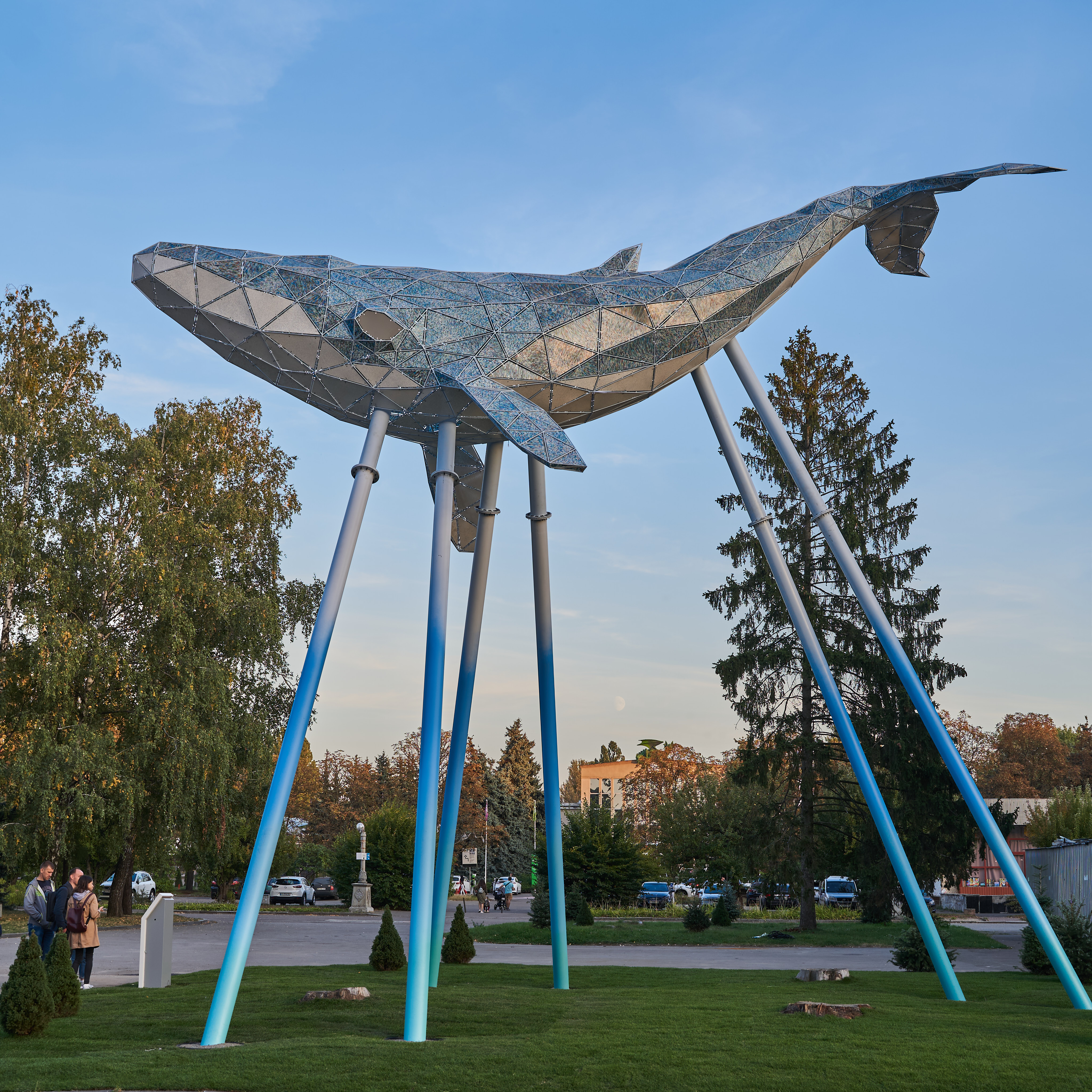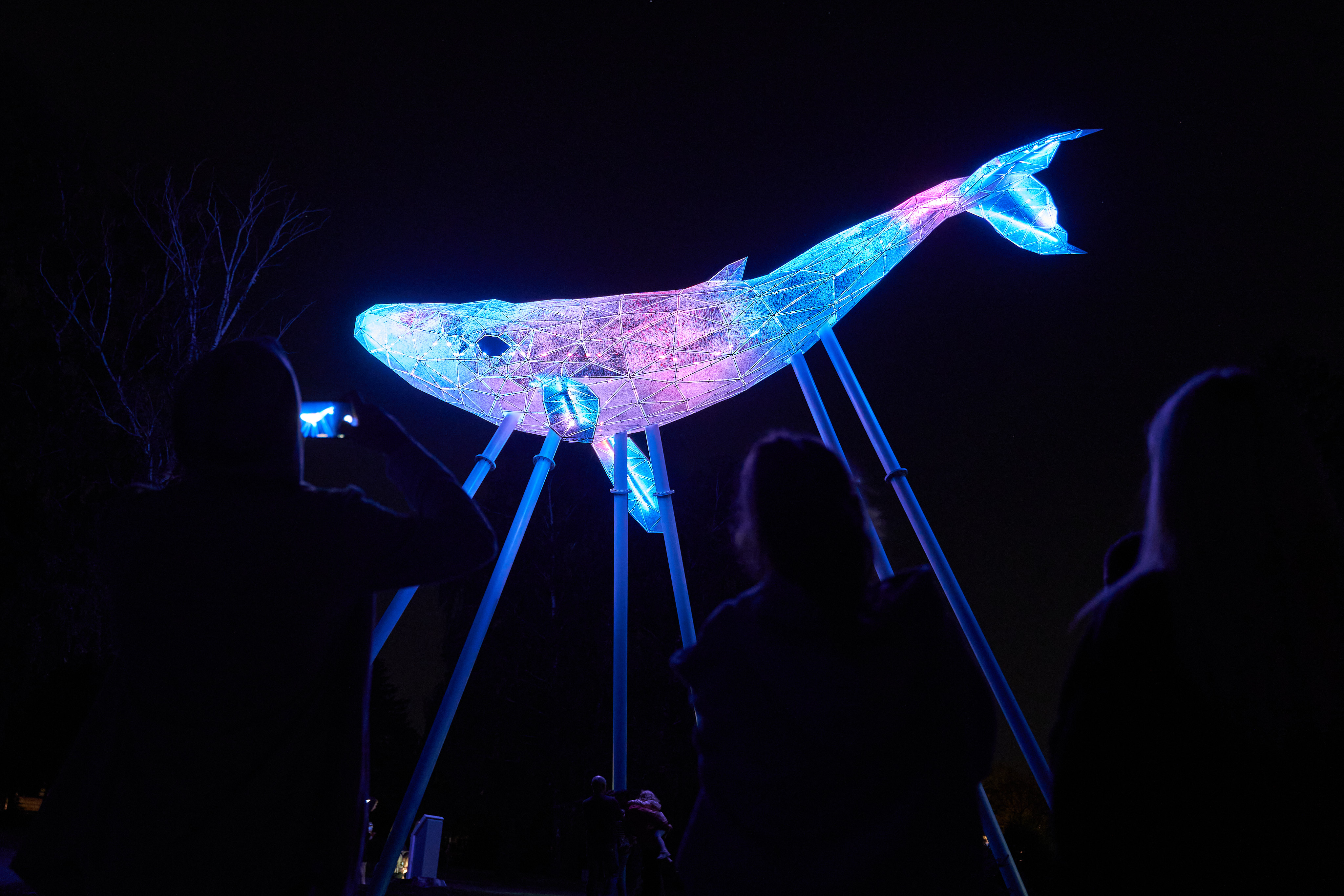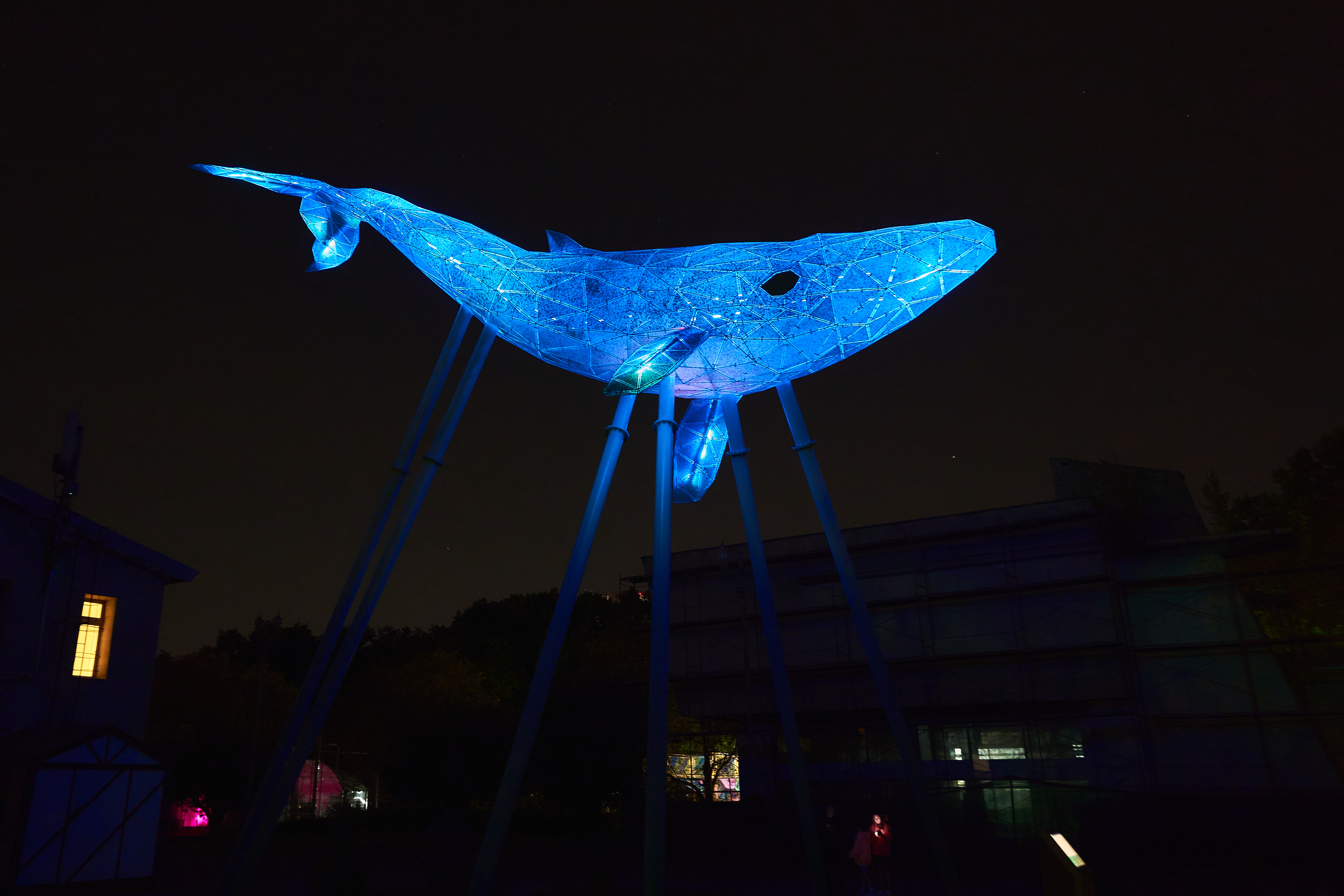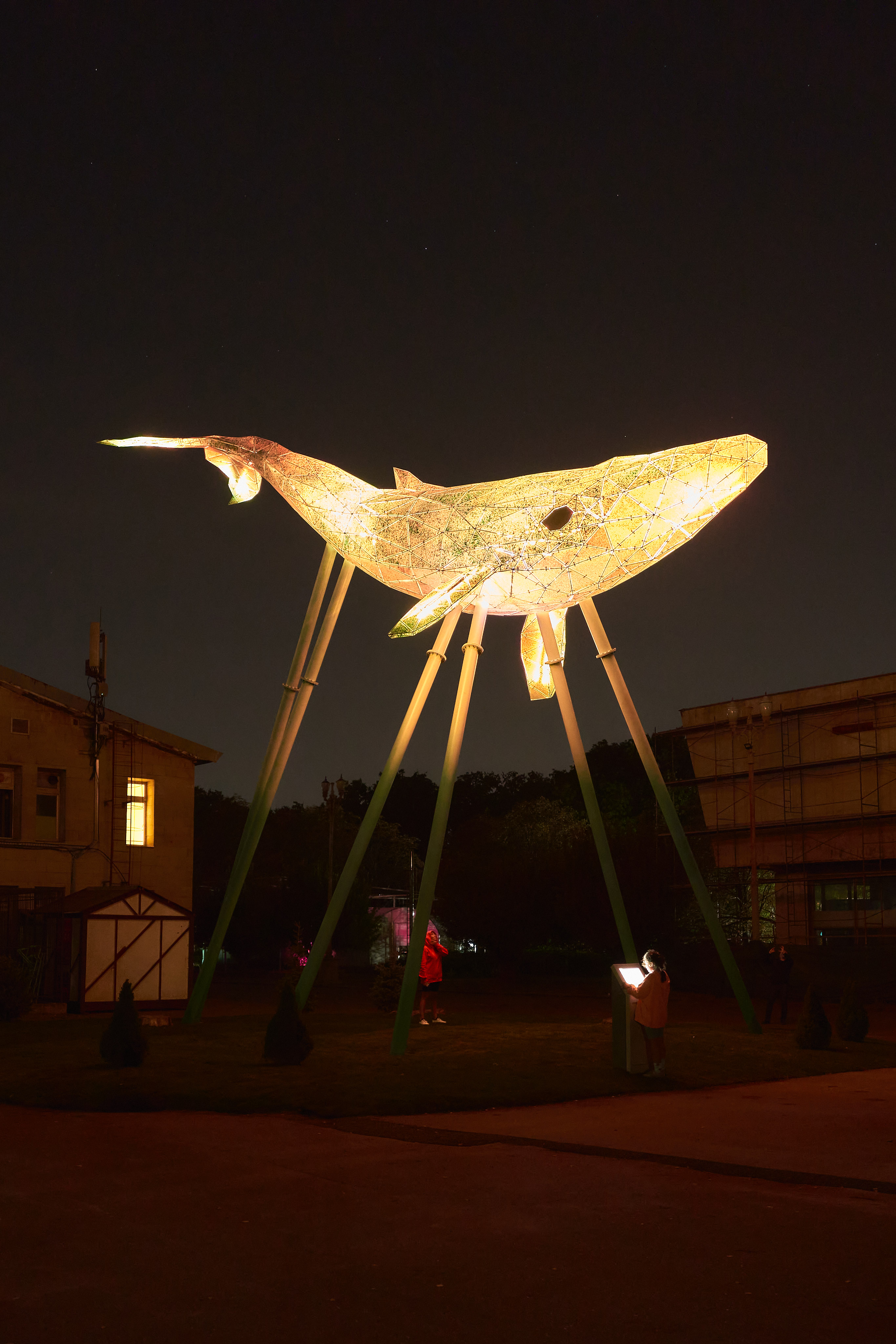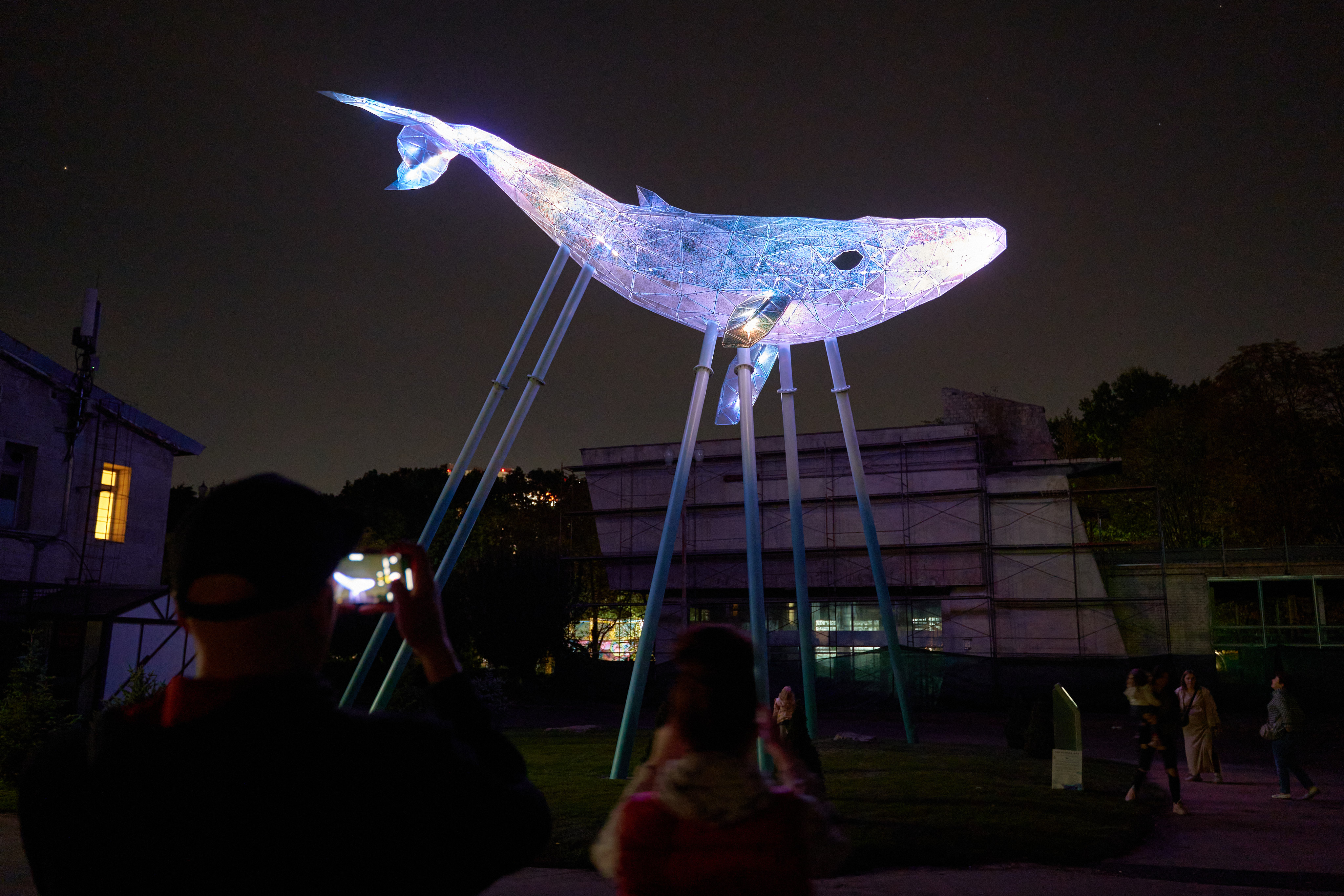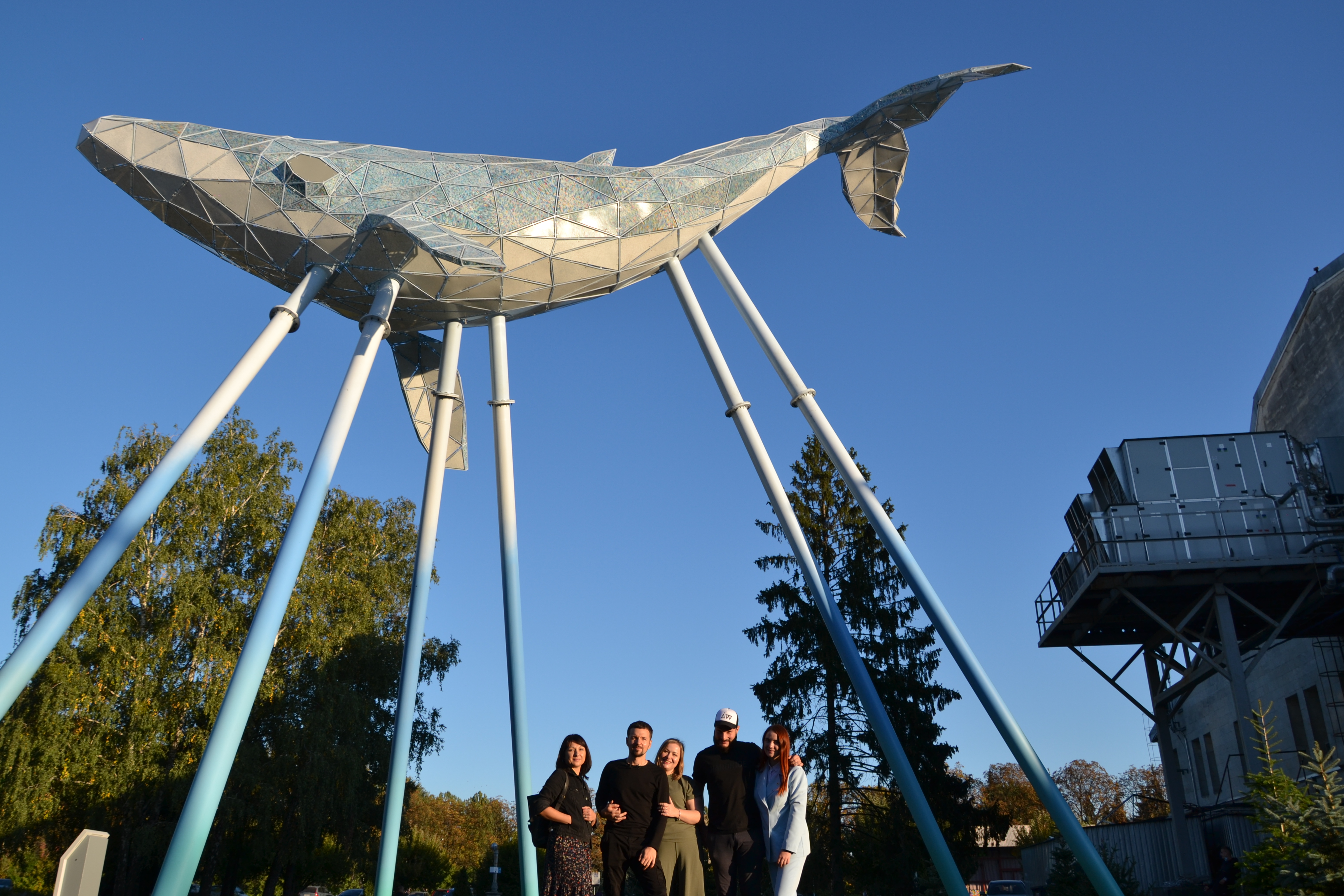Shaping a circular industrial ecosystem and supporting life-cycle thinking
Kyiv Whale
Kyiv Whale: Transforming Plastic Waste into Smart Media Art for Inclusive Urban Regeneration
Kyiv Whale transforms plastic waste into Ukraine’s largest 12-meter smart media sculpture, merging circular ecosystem, technology, education, and community action. Engaging students, activists, and festival-goers—it proves sustainability can be beautiful, participatory, inclusive, innovative, and useful. Its dynamic lighting reacts to real-time air and water quality, making pollution visible. More than art, it is a symbol of circular, sustainable transformation and inclusive urban regeneration.
Ukraine
National
Mainly urban
It refers to a physical transformation of the built environment (hard investment)
Yes
2022-02-15
No
No
No
As an individual partnership with other persons/organisation(s)
Kyiv Whale redefines urban sustainability by transforming plastic waste into Ukraine’s largest 12-meter smart media sculpture, merging circular economy, technology, education, and community action. The project proves sustainability can be beautiful, participatory, and innovative, while fostering environmental awareness and behavioral change.
Kyiv Whale engaged over 2,000 people—students, activists, festival-goers, and NGOs—who collected plastic, participated in educational programs, and co-created the sculpture. A nationwide media campaign reached 120,000+ active participants and informed 1,000,000+ people, promoting circular thinking and sustainability practices.
✅ Reconnecting with nature – The interactive sculpture visualizes air and water pollution through dynamic lighting and sound, making environmental issues tangible.
✅ Regaining a sense of belonging – Installed on a historically significant site, Kyiv Whale revives a forgotten landmark, reinforcing community identity.
✅ Prioritizing underserved communities – By integrating public education and participatory design, the project empowers citizens to take ownership of their urban space.
✅ Circular economy & scalability – The project proves recycled materials can create cutting-edge urban landmarks, offering a replicable model for other cities.
Kyiv Whale embodies sustainability, inclusion, and beauty, turning urban waste into aesthetic, technological, and social innovation. By making pollution visible and integrating co-creation, the project inspires lasting behavioral change and serves as a blueprint for sustainable urban transformation across Europe.
By bridging art, ecology, and technology, Kyiv Whale educates communities on circular economy principles, fosters collective responsibility, and serves as a scalable model for cities seeking to merge sustainability with smart urban design.
Kyiv Whale drives environmental transformation inspiring cities across Europe to follow its example.
Kyiv Whale engaged over 2,000 people—students, activists, festival-goers, and NGOs—who collected plastic, participated in educational programs, and co-created the sculpture. A nationwide media campaign reached 120,000+ active participants and informed 1,000,000+ people, promoting circular thinking and sustainability practices.
✅ Reconnecting with nature – The interactive sculpture visualizes air and water pollution through dynamic lighting and sound, making environmental issues tangible.
✅ Regaining a sense of belonging – Installed on a historically significant site, Kyiv Whale revives a forgotten landmark, reinforcing community identity.
✅ Prioritizing underserved communities – By integrating public education and participatory design, the project empowers citizens to take ownership of their urban space.
✅ Circular economy & scalability – The project proves recycled materials can create cutting-edge urban landmarks, offering a replicable model for other cities.
Kyiv Whale embodies sustainability, inclusion, and beauty, turning urban waste into aesthetic, technological, and social innovation. By making pollution visible and integrating co-creation, the project inspires lasting behavioral change and serves as a blueprint for sustainable urban transformation across Europe.
By bridging art, ecology, and technology, Kyiv Whale educates communities on circular economy principles, fosters collective responsibility, and serves as a scalable model for cities seeking to merge sustainability with smart urban design.
Kyiv Whale drives environmental transformation inspiring cities across Europe to follow its example.
Smart Art
Circular Economy
Community Engagement
Urban Regeneration
Sustainability
Kyiv Whale exemplifies sustainability by transforming plastic waste into a durable, high-tech public landmark, proving that circularity can be both functional and visually striking. The project merges waste management, environmental education, and smart urban design, showcasing a scalable, replicable model for sustainable urban transformation.
Key Sustainability Objectives & Achievements:
✅ Transforming waste into value – Over 3,000 kg of plastic waste was collected, sorted, and repurposed into a long-lasting, weather-resistant structure, demonstrating the potential of circular materials in urban infrastructure.
✅ Behavioral change through participation – More than 2,000 people actively contributed, while an information campaign reached 1,000,000+ people, fostering a shift in attitudes toward recycling and circularity.
✅ Interactive environmental awareness – The sculpture monitors real-time air and water quality, turning pollution into a visible, emotional experience, encouraging citizens to engage with ecological data in a personal way.
✅ Scalability & Replication – Kyiv Whale serves as a replicable model for other cities, proving that sustainable urban art can merge public engagement, circular economy, and smart design to address waste reduction and urban renewal.
Sustainability Impact
Kyiv Whale is now an ecological symbol of the city, a permanent reminder that everything in nature is interconnected. It highlights how waste management choices impact air, water, biodiversity, and environmental health. By continuously engaging the public, the project fosters long-term environmental responsibility, encouraging sustainable habits in daily life.
Kyiv Whale demonstrates a new standard for sustainable public art, aligning with the New European Bauhaus vision. It is not just a sculpture but a living demonstration of circularity in action, empowering communities to see waste as a resource, inspiring cities to adopt innovative approaches to sustainability.
Key Sustainability Objectives & Achievements:
✅ Transforming waste into value – Over 3,000 kg of plastic waste was collected, sorted, and repurposed into a long-lasting, weather-resistant structure, demonstrating the potential of circular materials in urban infrastructure.
✅ Behavioral change through participation – More than 2,000 people actively contributed, while an information campaign reached 1,000,000+ people, fostering a shift in attitudes toward recycling and circularity.
✅ Interactive environmental awareness – The sculpture monitors real-time air and water quality, turning pollution into a visible, emotional experience, encouraging citizens to engage with ecological data in a personal way.
✅ Scalability & Replication – Kyiv Whale serves as a replicable model for other cities, proving that sustainable urban art can merge public engagement, circular economy, and smart design to address waste reduction and urban renewal.
Sustainability Impact
Kyiv Whale is now an ecological symbol of the city, a permanent reminder that everything in nature is interconnected. It highlights how waste management choices impact air, water, biodiversity, and environmental health. By continuously engaging the public, the project fosters long-term environmental responsibility, encouraging sustainable habits in daily life.
Kyiv Whale demonstrates a new standard for sustainable public art, aligning with the New European Bauhaus vision. It is not just a sculpture but a living demonstration of circularity in action, empowering communities to see waste as a resource, inspiring cities to adopt innovative approaches to sustainability.
Kyiv Whale demonstrates how public art can merge aesthetics, technology, and sustainability, offering a unique cultural and sensory experience. Designed as a dynamic, interactive landmark, it blends urban design with environmental awareness, making sustainability visible, engaging, and emotionally resonant. Through its striking form, audiovisual performances, and community-driven creation, it redefines how people interact with public spaces, turning a recycled material installation into a symbol of innovation and shared responsibility.
✅ A visually striking, interactive landmark – Kyiv Whale’s modern design, made from precision-molded recycled plastic, integrates into the urban landscape while standing out as a vibrant illuminated artwork. Its lighting and sound systems respond to real-time air and water quality, turning pollution into a sensory experience. At scheduled times, the sculpture transforms into a captivating audiovisual show, attracting visitors.
✅ A cultural and tourist attraction – Kyiv Whale has become a must-visit destination, drawing both locals and tourists.
✅ Cultural continuity & emotional impact – Installed where a whale sculpture stood 40 years ago, Kyiv Whale revives historical identity in a futuristic form.
✅ Elevating circular design – Kyiv Whale proving that recycled materials can be used in aspirational, cutting-edge urban design that enhances public space rather than just serving a functional role.
✅ Public engagement & social interaction – Kyiv Whale is a gathering point and cultural attraction. Its audiovisual performances foster shared experiences, making sustainability a part of daily urban life.
Kyiv Whale is a cultural and tourist landmark. As an environmental awareness tool, it shows how urban art inspires, educates, and creates lasting connections. It merges design, technology, and sustainability to transform urban spaces into interactive, meaningful places that connect people to their environment.
✅ A visually striking, interactive landmark – Kyiv Whale’s modern design, made from precision-molded recycled plastic, integrates into the urban landscape while standing out as a vibrant illuminated artwork. Its lighting and sound systems respond to real-time air and water quality, turning pollution into a sensory experience. At scheduled times, the sculpture transforms into a captivating audiovisual show, attracting visitors.
✅ A cultural and tourist attraction – Kyiv Whale has become a must-visit destination, drawing both locals and tourists.
✅ Cultural continuity & emotional impact – Installed where a whale sculpture stood 40 years ago, Kyiv Whale revives historical identity in a futuristic form.
✅ Elevating circular design – Kyiv Whale proving that recycled materials can be used in aspirational, cutting-edge urban design that enhances public space rather than just serving a functional role.
✅ Public engagement & social interaction – Kyiv Whale is a gathering point and cultural attraction. Its audiovisual performances foster shared experiences, making sustainability a part of daily urban life.
Kyiv Whale is a cultural and tourist landmark. As an environmental awareness tool, it shows how urban art inspires, educates, and creates lasting connections. It merges design, technology, and sustainability to transform urban spaces into interactive, meaningful places that connect people to their environment.
Kyiv Whale exemplifies inclusive public art, engaging diverse communities in its creation and impact. More than a sculpture, it is a collective symbol of environmental and social responsibility, demonstrating how participatory design, accessibility, and education shape urban spaces.
Key Inclusion Achievements
✅ A community-driven initiative – Over 2,000 people—students, activists, festival-goers, and NGOs—collected plastic and contributed to the sculpture’s creation, making them feel personally connected to the final artwork.
✅ A large-scale educational and media campaign – Kyiv Whale was introduced through environmental education programs, media, and events raising awareness about circular economy and public participation, ensuring that everyone had the chance to contribute to the project. This prepared society for its arrival, creating a deep sense of involvement even before the sculpture was built.
✅ Broad accessibility & affordability – Located in a public space, Kyiv Whale offers free access to all, removing financial barriers and making interactive art accessible to everyone.
✅ Engaging underserved communities – The project reached youth, low-income groups, and people with limited access to cultural activities, ensuring that sustainability and art were not limited to privileged audiences.
✅ Inclusive design & multisensory experience – Kyiv Whale’s lighting and sound system allow engagement through visual and auditory interaction, making it inclusive for people with disabilities.
✅ Empowering citizens beyond the project – Kyiv Whale sparked long-term community engagement, encouraging people to see waste as a resource and public spaces as shared cultural assets. Participants now advocate for sustainability.
Impact & Exemplary Model
Kyiv Whale is a replicable model for inclusive urban transformation. By integrating public participation, accessibility, and education, it shows that urban spaces can be catalysts for collective action.
Key Inclusion Achievements
✅ A community-driven initiative – Over 2,000 people—students, activists, festival-goers, and NGOs—collected plastic and contributed to the sculpture’s creation, making them feel personally connected to the final artwork.
✅ A large-scale educational and media campaign – Kyiv Whale was introduced through environmental education programs, media, and events raising awareness about circular economy and public participation, ensuring that everyone had the chance to contribute to the project. This prepared society for its arrival, creating a deep sense of involvement even before the sculpture was built.
✅ Broad accessibility & affordability – Located in a public space, Kyiv Whale offers free access to all, removing financial barriers and making interactive art accessible to everyone.
✅ Engaging underserved communities – The project reached youth, low-income groups, and people with limited access to cultural activities, ensuring that sustainability and art were not limited to privileged audiences.
✅ Inclusive design & multisensory experience – Kyiv Whale’s lighting and sound system allow engagement through visual and auditory interaction, making it inclusive for people with disabilities.
✅ Empowering citizens beyond the project – Kyiv Whale sparked long-term community engagement, encouraging people to see waste as a resource and public spaces as shared cultural assets. Participants now advocate for sustainability.
Impact & Exemplary Model
Kyiv Whale is a replicable model for inclusive urban transformation. By integrating public participation, accessibility, and education, it shows that urban spaces can be catalysts for collective action.
Kyiv Whale is a community-driven initiative, where citizens were not just spectators but active participants in its creation, implementation, and long-term impact. The project engaged over 2,000 people through plastic collection, educational programs, and creative participation, ensuring it became a symbol of collective action and shared values.
Key Levels of Citizen Involvement
✅ Hands-on participation – Citizens collected, sorted, and contributed plastic waste, experiencing firsthand how waste can be repurposed into meaningful art. This transformed recycling from an abstract concept into a tangible experience, fostering personal connection and ownership.
✅ Educational & awareness campaigns – A six-month campaign engaged schools, universities, and NGOs through workshops and media outreach, promoting circular economy and sustainability. This ensured citizens were not just passive observers but informed contributors.
✅ Co-creation and decision-making – Citizens participated in community events and discussions, influencing aspects of the project’s vision. The visualization of the final sculpture before its creation motivated people to contribute.
✅ Shifting public perception of waste – Kyiv Whale sparked reflection among a broad audience on how they manage waste. Seeing plastic transformed into a cultural landmark encouraged greater awareness and responsibility.
✅ Long-term community impact – Contributors feel a lasting connection to the artwork, strengthening civic pride and engagement. The sculpture remains a platform for public dialogue on sustainability, inspiring further circular economy initiatives.
High citizen involvement made Kyiv Whale more than a sculpture—it became a symbol of collective action and environmental responsibility. Public participation amplified its reach and long-term relevance.
The project proves that when communities actively contribute, they create spaces that reflect shared values and inspire lasting change.
Key Levels of Citizen Involvement
✅ Hands-on participation – Citizens collected, sorted, and contributed plastic waste, experiencing firsthand how waste can be repurposed into meaningful art. This transformed recycling from an abstract concept into a tangible experience, fostering personal connection and ownership.
✅ Educational & awareness campaigns – A six-month campaign engaged schools, universities, and NGOs through workshops and media outreach, promoting circular economy and sustainability. This ensured citizens were not just passive observers but informed contributors.
✅ Co-creation and decision-making – Citizens participated in community events and discussions, influencing aspects of the project’s vision. The visualization of the final sculpture before its creation motivated people to contribute.
✅ Shifting public perception of waste – Kyiv Whale sparked reflection among a broad audience on how they manage waste. Seeing plastic transformed into a cultural landmark encouraged greater awareness and responsibility.
✅ Long-term community impact – Contributors feel a lasting connection to the artwork, strengthening civic pride and engagement. The sculpture remains a platform for public dialogue on sustainability, inspiring further circular economy initiatives.
High citizen involvement made Kyiv Whale more than a sculpture—it became a symbol of collective action and environmental responsibility. Public participation amplified its reach and long-term relevance.
The project proves that when communities actively contribute, they create spaces that reflect shared values and inspire lasting change.
Kyiv Whale was realized through multi-level collaboration, engaging government agencies, cultural institutions, environmental organizations, and local communities. This broad support ensured strong institutional backing, high community involvement, and significant environmental impact.
✅ Local level (citizens, schools, NGOs, urban community)
Over 2,000 people, including students from 25 schools, actively participated in plastic collection, clean-up events, and educational programs. The project mobilized community, making waste collection an accessible and engaging activity. The location at VDNG was chosen due to public demand to revive the historical whale sculpture that once stood there.
✅ Municipal & regional level (Kyiv authorities, urban planners, cultural institutions)
Kyiv City Administration, the Department of Environmental Protection, and district authorities facilitated installation and ensured urban integration. The National Complex “Expocenter of Ukraine” (VDNG) endorsed the project, recognizing its cultural and ecological significance. Local urban planners helped embed the sculpture into the city’s architectural vision.
✅ National level (Ministries, public institutions, media partners)
Kyiv Whale received support from the Ministry of Culture and the Ministry of Environmental Protection, with official letters from ministers and government officials highlighting its dual role as an artistic and environmental awareness initiative. The Ukrainian Cultural Fund backed the project financially, while media partners reaching over 1 million people.
✅ European level (international cultural and sustainability networks)
Kyiv Whale was introduced within European cultural and environmental discussions. The project gained interest as a replicable model for sustainable urban art, contributing to the New European Bauhaus vision.
This collaborative approach ensured strong community ownership, institutional legitimacy, and long-term sustainability.
✅ Local level (citizens, schools, NGOs, urban community)
Over 2,000 people, including students from 25 schools, actively participated in plastic collection, clean-up events, and educational programs. The project mobilized community, making waste collection an accessible and engaging activity. The location at VDNG was chosen due to public demand to revive the historical whale sculpture that once stood there.
✅ Municipal & regional level (Kyiv authorities, urban planners, cultural institutions)
Kyiv City Administration, the Department of Environmental Protection, and district authorities facilitated installation and ensured urban integration. The National Complex “Expocenter of Ukraine” (VDNG) endorsed the project, recognizing its cultural and ecological significance. Local urban planners helped embed the sculpture into the city’s architectural vision.
✅ National level (Ministries, public institutions, media partners)
Kyiv Whale received support from the Ministry of Culture and the Ministry of Environmental Protection, with official letters from ministers and government officials highlighting its dual role as an artistic and environmental awareness initiative. The Ukrainian Cultural Fund backed the project financially, while media partners reaching over 1 million people.
✅ European level (international cultural and sustainability networks)
Kyiv Whale was introduced within European cultural and environmental discussions. The project gained interest as a replicable model for sustainable urban art, contributing to the New European Bauhaus vision.
This collaborative approach ensured strong community ownership, institutional legitimacy, and long-term sustainability.
Kyiv Whale united experts and communities across art, design, environmental science, engineering, digital technology, education, and communications. Artists and designers shaped the sculpture’s aesthetic and conceptual vision, ensuring that recycled plastic panels conveyed a sleek, futuristic form rather than a traditional "recycled look." Environmental scientists guided material selection and advised on integrating real-time air and water sensors, ensuring data accuracy and relevance.
Engineers and technologists developed the interactive lighting and sound systems, translating sensor inputs into dynamic artistic expressions that made pollution data tangible for citizens. Educators and environmental NGOs orchestrated large-scale awareness and waste collection campaigns—engaging over 2,000 participants in schools, universities, and festivals. This participatory approach transformed waste collection into a co-creation process, fostering a sense of shared ownership.
A dedicated communications and media strategy amplified the project’s impact, reaching over 1 million people through digital campaigns, press coverage, and public storytelling. By shifting perceptions of waste and sustainability, Kyiv Whale became a catalyst for cultural transformation and long-term behavioral change.
Local policymakers and urban planners facilitated site selection and approvals, ensuring that the sculpture became part of the city's cultural and historical landscape. The added value of this interdisciplinary collaboration was the creation of an artwork that is simultaneously a technological innovation, an educational tool, and a community-driven movement. By merging expertise from diverse fields, Kyiv Whale evolved beyond sculpture into an urban transformation model—showing how art, technology, science, communications, and civic engagement can reshape cities, inspire behavioral change, and promote circular thinking.
Engineers and technologists developed the interactive lighting and sound systems, translating sensor inputs into dynamic artistic expressions that made pollution data tangible for citizens. Educators and environmental NGOs orchestrated large-scale awareness and waste collection campaigns—engaging over 2,000 participants in schools, universities, and festivals. This participatory approach transformed waste collection into a co-creation process, fostering a sense of shared ownership.
A dedicated communications and media strategy amplified the project’s impact, reaching over 1 million people through digital campaigns, press coverage, and public storytelling. By shifting perceptions of waste and sustainability, Kyiv Whale became a catalyst for cultural transformation and long-term behavioral change.
Local policymakers and urban planners facilitated site selection and approvals, ensuring that the sculpture became part of the city's cultural and historical landscape. The added value of this interdisciplinary collaboration was the creation of an artwork that is simultaneously a technological innovation, an educational tool, and a community-driven movement. By merging expertise from diverse fields, Kyiv Whale evolved beyond sculpture into an urban transformation model—showing how art, technology, science, communications, and civic engagement can reshape cities, inspire behavioral change, and promote circular thinking.
Kyiv Whale stands apart from traditional public art and recycling-based sculptures by merging circular economy principles, smart technology, and participatory engagement into a high-tech, immersive urban landmark. Unlike conventional sustainability projects that focus solely on awareness, Kyiv Whale transforms waste into a functional, interactive, and educational experience, making sustainability both tangible and inspiring.
How Kyiv Whale Innovates Beyond Mainstream Practices
✅ From Waste to Smart Urban Art
Most recycling-based sculptures leave visible traces of waste, reinforcing its low-value perception. Kyiv Whale challenges this by using precision-molded recycled plastic, creating a sleek, durable landmark that blends sustainability with cutting-edge design.
✅ Immersive Interaction with Environmental Data
Unlike static urban sculptures, Kyiv Whale visualizes air and water quality through dynamic lighting and sound, turning abstract pollution data into a sensory-driven experience. This makes sustainability tangible and engaging, bridging technology and ecology.
✅ Participatory Circular Economy
Rather than relying on passive awareness campaigns, Kyiv Whale involved citizens in plastic collection, making the final sculpture a shared symbol of action. This shifts circular economy from a theoretical concept to a lived experience, inspiring long-term behavioral change.
✅ Urban Renewal through Cultural Innovation
Installed at a historical site where a whale sculpture once stood, the project revitalized a forgotten cultural landmark in a sustainable, future-oriented form. This sets a new precedent for integrating ecological and cultural heritage in urban design.
A Scalable Model for the Future
Kyiv Whale introduces a replicable approach for cities seeking to merge art, technology, and sustainability. By turning waste into cultural infrastructure, it demonstrates how public spaces can engage citizens in sustainability in a transformative way.
How Kyiv Whale Innovates Beyond Mainstream Practices
✅ From Waste to Smart Urban Art
Most recycling-based sculptures leave visible traces of waste, reinforcing its low-value perception. Kyiv Whale challenges this by using precision-molded recycled plastic, creating a sleek, durable landmark that blends sustainability with cutting-edge design.
✅ Immersive Interaction with Environmental Data
Unlike static urban sculptures, Kyiv Whale visualizes air and water quality through dynamic lighting and sound, turning abstract pollution data into a sensory-driven experience. This makes sustainability tangible and engaging, bridging technology and ecology.
✅ Participatory Circular Economy
Rather than relying on passive awareness campaigns, Kyiv Whale involved citizens in plastic collection, making the final sculpture a shared symbol of action. This shifts circular economy from a theoretical concept to a lived experience, inspiring long-term behavioral change.
✅ Urban Renewal through Cultural Innovation
Installed at a historical site where a whale sculpture once stood, the project revitalized a forgotten cultural landmark in a sustainable, future-oriented form. This sets a new precedent for integrating ecological and cultural heritage in urban design.
A Scalable Model for the Future
Kyiv Whale introduces a replicable approach for cities seeking to merge art, technology, and sustainability. By turning waste into cultural infrastructure, it demonstrates how public spaces can engage citizens in sustainability in a transformative way.
Kyiv Whale was developed through a unique, replicable methodology, merging education, direct community action, and smart urban design. Unlike mainstream projects that rely solely on awareness, Kyiv Whale offered people a way to learn, act, and co-create, ensuring long-term behavioral change and a sense of ownership over the final artwork.
✅ From Inspiration to Action:
Kyiv Whale was designed not just as a sculpture but as a catalyst for action - the project presented an inspiring visual concept that motivated people to participate in it, knowing their efforts would be transformed into a unique Smart immersive landmark - con light, sound and sensors of pollution, largest 12-meters recycling-art piece in Ukraine.
✅ Learning by Doing:
Participants didn’t just learn about recycling—they actively contributed to a circular economy process. Those involved, especially children, were later recognized with awards, reinforcing a sense of ownership and achievement.
✅ Building Public Anticipation & Engagement
A six-month media campaign prepared society for the arrival of Kyiv Whale. By showcasing its future design, technological features, and location, the campaign fostered curiosity, excitement, and broad public support. The methodology ensured participation across various sectors—from students and NGO to governmental bodies and cultural institutions.
✅ A Scalable, Repeatable Model for European Cities
Kyiv Whale was designed as a blueprint for replication. Its methodology can easily be adopted in new locations, proving that cities can replace waste and pollution with artistic, high-tech landmarks that reflect their own environmental and cultural identity.
Kyiv Whale moves beyond mainstream sustainability efforts by offering a structured, interactive process that blends environmental awareness, artistic expression, and community participation. It proves that when people see their actions create real change, they become long-term advocates for sustainability.
✅ From Inspiration to Action:
Kyiv Whale was designed not just as a sculpture but as a catalyst for action - the project presented an inspiring visual concept that motivated people to participate in it, knowing their efforts would be transformed into a unique Smart immersive landmark - con light, sound and sensors of pollution, largest 12-meters recycling-art piece in Ukraine.
✅ Learning by Doing:
Participants didn’t just learn about recycling—they actively contributed to a circular economy process. Those involved, especially children, were later recognized with awards, reinforcing a sense of ownership and achievement.
✅ Building Public Anticipation & Engagement
A six-month media campaign prepared society for the arrival of Kyiv Whale. By showcasing its future design, technological features, and location, the campaign fostered curiosity, excitement, and broad public support. The methodology ensured participation across various sectors—from students and NGO to governmental bodies and cultural institutions.
✅ A Scalable, Repeatable Model for European Cities
Kyiv Whale was designed as a blueprint for replication. Its methodology can easily be adopted in new locations, proving that cities can replace waste and pollution with artistic, high-tech landmarks that reflect their own environmental and cultural identity.
Kyiv Whale moves beyond mainstream sustainability efforts by offering a structured, interactive process that blends environmental awareness, artistic expression, and community participation. It proves that when people see their actions create real change, they become long-term advocates for sustainability.
High Potential for Transferability and Replicability
Kyiv Whale is a scalable model that merges education, circular economy, and smart urban design. Its step-by-step methodology makes it easy to replicate in various cities and contexts.
Key Transferable Elements
✅ Education & Community Engagement
The project starts with a strong awareness campaign, using 3D visualization of the sculpture to inspire participation. Citizens learn about sustainability through workshops, clean-ups, and media outreach, fostering long-term commitment. People can also contribute remotely by sending plastic waste to recycling stations under the project’s name.
✅ Circular Economy & Sustainable Production
Collected plastics are processed using Precious Plastic technology, turning waste into panels for the sculpture. This method can be adapted to different waste management systems worldwide.
✅ Public Participation in Urban Planning
Communities take part in site selection discussions, ensuring the sculpture is placed in a culturally significant location, reinforcing local identity and civic engagement.
✅ Smart Art & Technology Integration
The sculpture is not just an artwork—it’s an interactive landmark with lighting, sound, sensors, and digital programming that visualizes environmental data. These elements can be customized for any city.
✅ Urban Revitalization & Local Impact
Beyond installation, the surrounding space is beautified, with landscaping, informational signage, and immersive shows, making it a city attraction.
✅ Scalability via a Mobile App
A multilingual app will support replication by providing project methodology and:
-Educational content on sustainability
-Event maps for clean-ups
-Voting for selection
-Live pollution data
-Show schedules & updates.
Kyiv Whale can be replicated anywhere with a committed local partner willing to bring an immersive, smart art experience to their community—turning sustainability into a movement and a landmark.
Kyiv Whale is a scalable model that merges education, circular economy, and smart urban design. Its step-by-step methodology makes it easy to replicate in various cities and contexts.
Key Transferable Elements
✅ Education & Community Engagement
The project starts with a strong awareness campaign, using 3D visualization of the sculpture to inspire participation. Citizens learn about sustainability through workshops, clean-ups, and media outreach, fostering long-term commitment. People can also contribute remotely by sending plastic waste to recycling stations under the project’s name.
✅ Circular Economy & Sustainable Production
Collected plastics are processed using Precious Plastic technology, turning waste into panels for the sculpture. This method can be adapted to different waste management systems worldwide.
✅ Public Participation in Urban Planning
Communities take part in site selection discussions, ensuring the sculpture is placed in a culturally significant location, reinforcing local identity and civic engagement.
✅ Smart Art & Technology Integration
The sculpture is not just an artwork—it’s an interactive landmark with lighting, sound, sensors, and digital programming that visualizes environmental data. These elements can be customized for any city.
✅ Urban Revitalization & Local Impact
Beyond installation, the surrounding space is beautified, with landscaping, informational signage, and immersive shows, making it a city attraction.
✅ Scalability via a Mobile App
A multilingual app will support replication by providing project methodology and:
-Educational content on sustainability
-Event maps for clean-ups
-Voting for selection
-Live pollution data
-Show schedules & updates.
Kyiv Whale can be replicated anywhere with a committed local partner willing to bring an immersive, smart art experience to their community—turning sustainability into a movement and a landmark.
Kyiv Whale directly addresses global environmental and societal challenges by providing a replicable local model merging sustainability, technology, and public engagement. While plastic waste, pollution, and urban sustainability affect cities worldwide, Kyiv Whale proves how circularity, participatory design, and digital innovation can create impactful community solutions.
Global Challenges & Local Solutions
✅ Plastic Waste & Circular Economy
🔹 Kyiv Whale upcycled plastic waste into a high-tech landmark, proving waste can become valuable infrastructure. Public participation reinforced circular economy principles in action.
✅ Air & Water Pollution & Public Awareness
🔹 Kyiv Whale makes pollution visible—its interactive lighting and sound respond to real-time environmental data, shifting awareness from abstract statistics to immersive experiences that encourage behavioral change.
✅ Urban Sustainability & Smart Cities
🔹 Unlike static urban art, Kyiv Whale actively benefits the environment while serving as a cultural and educational hub. It offers a replicable model for cities to integrate smart, sustainable landmarks into urban renewal efforts.
✅ Community Engagement & Public Participation
🔹 Kyiv Whale fosters civic engagement by combining education with action. Citizens actively shape the sculpture, creating a sense of ownership and responsibility that ensures lasting impact.
✅ Scalability & Global Replication
🔹 Designed for easy replication, Kyiv Whale provides a blueprint adaptable to different urban environments, using its methodology, materials, and interactive features.
Kyiv Whale is more than a sculpture—it’s a proof of concept that environmental challenges can become opportunities for innovation, cultural engagement, and behavioral change. By merging circular economy, interactive technology, and community action, it delivers a scalable, impactful, and transformative solution to a global crisis.
Global Challenges & Local Solutions
✅ Plastic Waste & Circular Economy
🔹 Kyiv Whale upcycled plastic waste into a high-tech landmark, proving waste can become valuable infrastructure. Public participation reinforced circular economy principles in action.
✅ Air & Water Pollution & Public Awareness
🔹 Kyiv Whale makes pollution visible—its interactive lighting and sound respond to real-time environmental data, shifting awareness from abstract statistics to immersive experiences that encourage behavioral change.
✅ Urban Sustainability & Smart Cities
🔹 Unlike static urban art, Kyiv Whale actively benefits the environment while serving as a cultural and educational hub. It offers a replicable model for cities to integrate smart, sustainable landmarks into urban renewal efforts.
✅ Community Engagement & Public Participation
🔹 Kyiv Whale fosters civic engagement by combining education with action. Citizens actively shape the sculpture, creating a sense of ownership and responsibility that ensures lasting impact.
✅ Scalability & Global Replication
🔹 Designed for easy replication, Kyiv Whale provides a blueprint adaptable to different urban environments, using its methodology, materials, and interactive features.
Kyiv Whale is more than a sculpture—it’s a proof of concept that environmental challenges can become opportunities for innovation, cultural engagement, and behavioral change. By merging circular economy, interactive technology, and community action, it delivers a scalable, impactful, and transformative solution to a global crisis.
Kyiv Whale has delivered measurable environmental, educational, social, and cultural impact, turning waste into a symbol of sustainability, innovation, and community action. By combining circular economy, participatory engagement, and smart urban design, the project has directly and indirectly benefited thousands of people while setting a replicable model for sustainable urban transformation.
Environmental Impact: Circular Economy & Waste Reduction
3,000+ kg of plastic waste collected through seven large-scale cleanup events, providing sufficient material for the sculpture’s panels.
Public cleanup events helped restore public spaces, raising awareness of waste management.
Kyiv Whale functions as an interactive pollution monitoring system, making air and water quality data visible to the public.
Social & Community Engagement
Over 2,000 citizens, including students and activists, actively participated in plastic collection and educational program.
A six-month digital campaign reached over 1,000,000 people, increasing awareness about environmental challenges and the importance of recycling.
Educational & Behavioral Change
The project combined education with hands-on experience, reinforcing sustainable habits by allowing people to directly contribute to the sculpture’s creation.
Participants continue recycling efforts, sharing their experience with friends and local communities.
Urban & Cultural Transformation
Kyiv Whale was officially presented and becoming a new cultural and environmental landmark.
It serves as a lasting symbol of civic action, reminding residents the importance of waste management.
As a highly visible urban artwork draws attention to sustainability issues and serves as an attraction for locals and tourists.
Scalability & Long-Term Influence
The project’s methodology is designed for replication, offering a scalable model for other cities to integrate circular economy principles into public art and urban renewal.
Environmental Impact: Circular Economy & Waste Reduction
3,000+ kg of plastic waste collected through seven large-scale cleanup events, providing sufficient material for the sculpture’s panels.
Public cleanup events helped restore public spaces, raising awareness of waste management.
Kyiv Whale functions as an interactive pollution monitoring system, making air and water quality data visible to the public.
Social & Community Engagement
Over 2,000 citizens, including students and activists, actively participated in plastic collection and educational program.
A six-month digital campaign reached over 1,000,000 people, increasing awareness about environmental challenges and the importance of recycling.
Educational & Behavioral Change
The project combined education with hands-on experience, reinforcing sustainable habits by allowing people to directly contribute to the sculpture’s creation.
Participants continue recycling efforts, sharing their experience with friends and local communities.
Urban & Cultural Transformation
Kyiv Whale was officially presented and becoming a new cultural and environmental landmark.
It serves as a lasting symbol of civic action, reminding residents the importance of waste management.
As a highly visible urban artwork draws attention to sustainability issues and serves as an attraction for locals and tourists.
Scalability & Long-Term Influence
The project’s methodology is designed for replication, offering a scalable model for other cities to integrate circular economy principles into public art and urban renewal.

